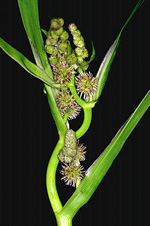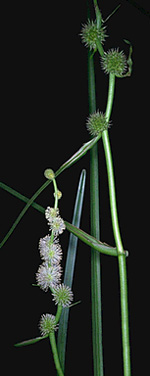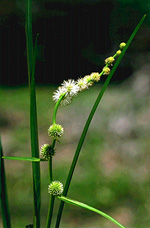 |
This small family of only one genus (Sparganium) is principally found in temperate parts of the Northern Hemisphere extending north into the Arctic, but also in Malesia, Australia and New Zealand. In Australia, these marsh plants occur from south-east Queensland through the south-eastern mainland to South Australia, and in Tasmania.
Characteristic features of the family Sparganiaceae in Australia include:
- sedge-like or reed-like aquatic plants with a creeping rhizome, and
floating or emergent linear leaves in 2 opposite rows on stems
- flowers small, unisexual, in burr-like globular clusters on sparsely
branching, elongate inflorescences
- perianth of 3 or 6 scale-like parts surrounding 1–8 stamens (male
flowers) or a superior, 2-carpellate ovary (female plants)
- fruit a dry or slightly fleshy drupe-like achene with a spongy outer
coat that allows it to float
Description
Perennial aquatic herbs rooted in the substrate with their
leaves floating or emergent. Perennating by rhizomes or corms. Vegetative
reproduction by rhizomes. Internal secretions not obvious. Plants glabrous.
Leaves distichous, both basal and cauline, sessile. Stipule-like lobes
absent. Lamina simple, symmetric, filiform, acicular, subulate or linear;
margins entire, ±flat; venation parallel, with the midrib conspicuous
or inconspicuous, and the tertiary venation not reticulate; surfaces not
punctate; herbaceous or succulent. Leaf ligule absent. Male and female
flowers occurring on the same plant. Inflorescences terminal, consisting
of capitula. Bracts present or absent. Pollination by wind. Flowers odourless,
sessile. Floral disc present or absent; nectaries absent. Perianth regular,
of 1 whorl only, or rarely apparently 2 ±similar whorls, with 3
(–6) free sepaloid segments, open in bud, herbaceous or papery. Fertile
stamens 1–8, opposite to and free of the perianth, free of the ovary and
style, distinct from each other, grouped or fused into bundles or fused
by their filaments into an open or closed tube, all ±equal. Anthers
basifixed, not versatile, opening sideways by longitudinal slits, 2-celled.
Ovary superior and sessile. Carpels 2, fused; ovary with 1–2 locules.
Style terminal, single and unbranched, or branched above, or from the
base. Ovules 1 per locule, sessile; placentation apical. Fruit derived
from one flower or several flowers (composite); dry, indehiscent; a globular
head of achenes (achenosum); the perianth on the maturing fruit dry and
persistent. Disseminule macro-surface featureless or bluntly costate;
micro-surface ±smooth, green or brown, dull. Seeds 1 (–2) per fruit.
Aril absent. Cotyledons 1. Embryo straight.
(Note: this description has been generated from the coded data compiled for the key. Any errors in the key data will be reflected in the descriptions.)
A treatment of the family Sparganiaceae has been published in:
Flora of Australia 45: 68.
Australian genera of Sparganiaceae (as recognised for the Flora of Australia)
† = some species native, others introduced
†Sparganium

|
  |

Sparganium erectum (flowers)
Photo: S.Jacobs © S.Jacobs

Sparganium subglobosum (flowers and fruits)
Photo: R.Hotchkiss © ANBG

Sparganium subglobosum (flowers)
Photo: S.Jacobs © S.Jacobs
|
 |
|